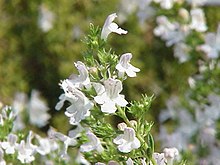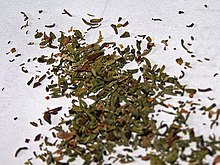bio.wikisort.org - Plant
Satureja is a genus of aromatic plants of the family Lamiaceae, related to rosemary and thyme. It is native to North Africa, southern and southeastern Europe, the Middle East, and Central Asia. A few New World species were formerly included in Satureja, but they have all been moved to other genera. Several species are cultivated as culinary herbs called savory, and they have become established in the wild in a few places.[1][2]
| Satureja | |
|---|---|
 | |
| Winter savory, Satureja montana | |
| Scientific classification | |
| Kingdom: | Plantae |
| Clade: | Tracheophytes |
| Clade: | Angiosperms |
| Clade: | Eudicots |
| Clade: | Asterids |
| Order: | Lamiales |
| Family: | Lamiaceae |
| Subfamily: | Nepetoideae |
| Tribe: | Mentheae |
| Genus: | Satureja L. |
| Synonyms[1] | |
| |
Description
Satureja species may be annual or perennial. They are low-growing herbs and subshrubs, reaching heights of 15–50 cm (5.9–19.7 in).
The leaves are 1–3 cm (0.39–1.18 in) long, with flowers forming in whorls on the stem, white to pale pink-violet.
Ecology and cultivation
Satureja species are food plants for the larva of some Lepidoptera (butterflies and moths). Caterpillars of the moth Coleophora bifrondella feed exclusively on winter savory (S. montana).
Savory may be grown purely for ornamental purposes; members of the genus need sun and well-drained soil.
Uses

Both summer savory (Satureja hortensis) and winter savory (Satureja montana) are used to flavor food. The former is preferred by cooks but as an annual is only available in summer; winter savory is an evergreen perennial.
Savory plays an important part in Armenian, Georgian, Bulgarian and Italian cuisine, particularly when cooking beans. It is also used to season the traditional Acadian stew known as fricot. Savory is also a key ingredient in sarmale, a stuffed cabbage dish in traditional Romanian cuisine. The modern spice mixture Herbes de Provence has savory as one of the principal ingredients.
In Azerbaijan, savory is often incorporated as a flavoring in black tea.
Species[1]

- Satureja adamovicii Šilic – Balkans
- Satureja aintabensis P.H.Davis – Turkey
- Satureja amani P.H.Davis – Turkey
- Satureja atropatana Bunge – Iran
- Satureja avromanica Maroofi – Iran
- Satureja bachtiarica Bunge – Iran
- Satureja boissieri Hausskn. ex Boiss. – Turkey, Iran
- Satureja bzybica Woronow – Caucasus
- Satureja × caroli-paui G.López – Spain (S. innota × S. montana)
- Satureja cilicica P.H.Davis – Turkey
- Satureja coerulea Janka – Bulgaria, Romania, Turkey
- Satureja cuneifolia Ten – Spain, Italy, Greece, Albania, Yugoslavia, Iraq
- Satureja × delpozoi Sánchez-Gómez, J.F.Jiménez & R.Morales – Spain (S. cuneifolia × S. intricata var. gracilis)
- Satureja edmondii Briq. – Iran
- Satureja × exspectata G.López – Spain (S. intricata var. gracilis × S. montana)
- Satureja fukarekii Šilic – Yugoslavia
- Satureja hellenica Halácsy – Greece
- Satureja hortensis L. – summer savory – Italy, Bulgaria, Albania, Yugoslavia, Crimea, Caucasus, Altai Republic, Kazakhstan, Xinjiang, western Himalayas; naturalized in western Mediterranean, Persian Gulf sheikdoms, Cuba, Dominican Republic, scattered locations in United States
- The heterogeneous mixture of the Satureja hortensis L. essential oil in water serves as a natural herbicide. The addition of this mixture inhibits the root elongation of weeds which reduces the weed's root-to-shoot ratio. This further reduces the weed's cell division and inhibits its germination, growth, and physiological processes.[4]
- Satureja horvatii Šilic – Greece, Yugoslavia
- Satureja icarica P.H.Davis – Greek Islands
- Satureja innota (Pau) Font Quer – Spain
- Satureja intermedia C.A.Mey. – Iran, Caucasus
- Satureja intricata Lange – Spain
- Satureja isophylla Rech.f. – Iran
- Satureja kallarica Jamzad – Iran
- Satureja kermanshahensis Jamzad – Iran
- Satureja khuzistanica Jamzad – Iran
- Satureja kitaibelii Wierzb. ex Heuff. – Bulgaria, Romania, Yugoslavia
- Satureja laxiflora K.Koch – Iran, Iraq, Turkey, Caucasus
- Satureja linearifolia (Brullo & Furnari) Greuter – Cyrenaica region of Libya
- Satureja macrantha C.A.Mey. – Iran, Iraq, Turkey, Caucasus
- Satureja metastasiantha Rech.f. – Iraq
- Satureja montana L. – winter savory – southern Europe, Turkey, Syria
- Satureja mutica Fisch. & C.A.Mey. – Caucasus, Iran, Turkmenistan
- Satureja nabateorum Danin & Hedge – Jordan
- Satureja × orjenii Šilic – Yugoslavia (S. horvatii × S. montana)
- Satureja pallaryi J.Thiébaut – Syria
- Satureja parnassica Heldr. & Sart. ex Boiss. – Greece, Turkey
- Satureja pilosa Velen. – Italy, Greece, Bulgaria
- Satureja rumelica Velen. – Bulgaria
- Satureja sahendica Bornm. – Iran
- Satureja salzmannii (Kuntze) P.W.Ball – Morocco, Spain
- Satureja spicigera (K.Koch) Boiss. – Turkey, Iran, Caucasus
- Satureja spinosa L. – Turkey, Greek Islands including Crete
- Satureja subspicata Bartl. ex Vis. – Austria, Yugoslavia, Albania, Bulgaria, Italy
- Satureja taurica Velen. – Crimea
- Satureja thymbra L. – Libya, southeastern Europe from Sardinia to Turkey; Cyprus, Lebanon, Palestine
- Satureja thymbrifolia Hedge & Feinbrun – Israel, Saudi Arabia
- Satureja visianii Šilic. – Yugoslavia
- Satureja wiedemanniana (Avé-Lall.) Velen. – Turkey
Formerly in Satureja
- Browne's savory, Clinopodium brownei (as Satureja brownei)
- San Miguel Savory, Clinopodium chandleri (as Satureja chandleri)
- Large-flowered calamint, Calamintha grandiflora (as Satureja grandiflora)
- Stone mint, Cunila mariana (as Satureja origanoides)
- Satureja acinos (L.) Scheele = Clinopodium acinos (L.) Kuntze
- Satureja alpina (L.) Scheele = Clinopodium alpinum (L.) Kuntze
- Satureja biflora (Buch.-Ham. ex D.Don) Benth = Micromeria biflora (Buch.-Ham. ex D.Don) Benth
- Satureja gillesii (Graham) Briq. = Clinopodium chilense (Benth.) Govaerts
- Satureja mexicana (Benth.) Briq. = Clinopodium mexicanum (Benth.) Govaerts
- Satureja multiflora (Ruiz & Pav.) Briq. – Chilean shrub mint = Clinopodium multiflorum (Ruiz & Pav.) Kuntze
- Satureja palmeri (A.Gray) Briq. (believed extinct; rediscovered 2001) = Clinopodium palmeri (A.Gray) Kuntze
- Satureja paradoxa (Vatke) Engl. ex Seybold = Clinopodium paradoxum (Vatke) Ryding
- Satureja robusta (Hook.f) Brenan = Clinopodium robustum (Hook.f) Ryding
- Satureja viminea L. – serpentine savory = Clinopodium vimineum (L.) Kuntze
- Satureja vulgaris (L.) Fritschl = Clinopodium vulgare L.
- Satureja vernayana Brenan = Clinopodium vernayanum (Brenan) Ryding
- Satureja douglasii (Benth.) Briq. – yerba buena (syn. S. chamissonis) = Micromeria douglasii Benth
Etymology
The etymology of the Latin word "satureia" is unclear. Speculation that it is related to saturare,[6] to satyr,[6] or to za'atar[7] is not well supported. The ancient Hebrew name is Tzatrah צתרה.
Notes
- "Kew World Checklist of Selected Plant Families".
- Altervista Flora Italiana, genere Satureja includes photos plus distribution maps for Europe + North America
- Moradi, Shirin; Sadeghi, Ehsan (2017). "Study of the antimicrobial effects of essential oil of Satureja edmondi and nisin on Staphylococcus aureus in commercial soup". Journal of Food Processing and Preservation. 41 (4): e13337. doi:10.1111/jfpp.13337.
- Hazrati, Hossein; Saharkhiz, Mohammad Jamal; Niakousari, Mehrdad; Moein, Mahmoodreza (August 2017). "Natural herbicide activity of Satureja hortensis L. essential oil nanoemulsion on the seed germination and morphophysiological features of two important weed species". Ecotoxicology and Environmental Safety. 142: 423–430. doi:10.1016/j.ecoenv.2017.04.041. ISSN 1090-2414. PMID 28456128.
- Abbasloo, Elham; Denhgan, Mohammad; Najafipour, Hamid; Vahidi, Reza; Dabiri, Shahriar; Sepehri, Gholamreza; Asadikaram, Gholamreza (September 21, 2016). "The anti-inflammatory properties of Satureja khuzistanica Jamzad essential oil attenuate the effects of traumatic brain injuries in rats". Scientific Reports. 6 (31866): 31866. Bibcode:2016NatSR...631866A. doi:10.1038/srep31866. PMC 4989136. PMID 27535591.
- F. E. J. Valpy, An Etymological Dictionary of the Latin Language, 1828, p. 542.
- DeBaggio, Thomas; Tucker, Arthur O. (2009). The encyclopedia of herbs : a comprehensive reference to herbs of flavor and fragrance (2nd ed.). Timber Press. ISBN 978-0881929942.
На других языках
- [en] Satureja
[es] Satureja
Las saturejas, ajedreas, saborijas o hisopillos (Satureja spp.) son un género de unas 50 especies aceptadas, de las casi 170 descritas,[2] de hierbas y arbustos de la familia de las lamiáceas, nativos de las regiones templadas del hemisferio norte. Varias especies se utilizan como hierbas aromáticas en gastronomía; en España se usan con frecuencia para aliñar aceitunas.[fr] Sarriette
Les Sarriettes ou Sariettes[1] (Satureja) forment un genre de plantes à fleurs aromatiques de la famille des Lamiacées, que l'on trouve notamment sur les bords des chemins méditerranéens. Les sarriettes sont parfois appelées Pèbre d'ai ou Pèbre d'ase (qui signifie en provençal « poivre d'âne »[2] en raison de vertus qui seraient aphrodisiaques, les coutumes locales qualifiant l'âne de "bien membré"), ou encore poivrette (en Valais et en Vallée d'Aoste). Elles sont aussi connues sous les noms de savourée, de sadrée et d'herbe de Saint Julien.[ru] Чабер
Ча́бер (иначе чабёр[2]) (лат. Satureja) — род растений семейства Яснотковые (Lamiaceae); однолетние растения, полукустарники или кустарники.Другой контент может иметь иную лицензию. Перед использованием материалов сайта WikiSort.org внимательно изучите правила лицензирования конкретных элементов наполнения сайта.
WikiSort.org - проект по пересортировке и дополнению контента Википедии